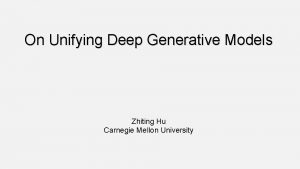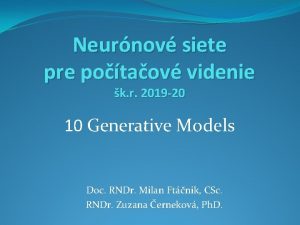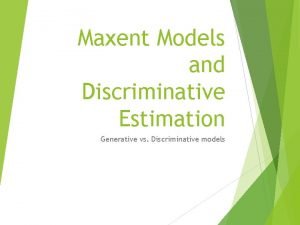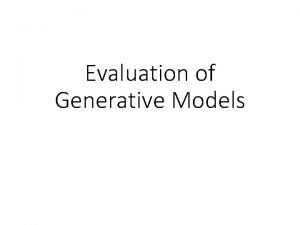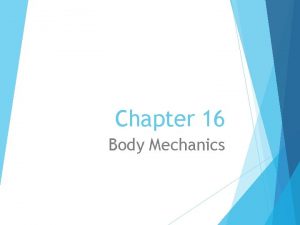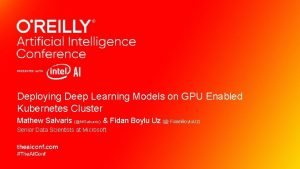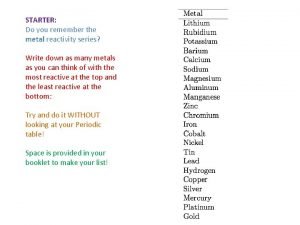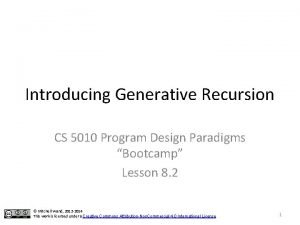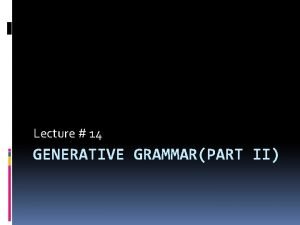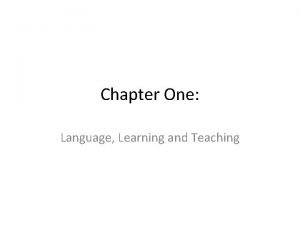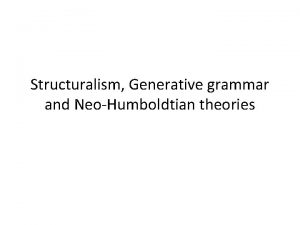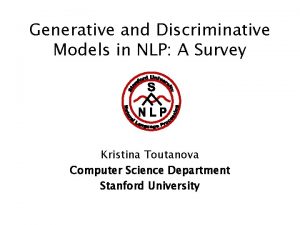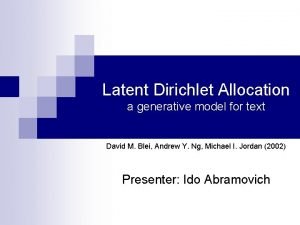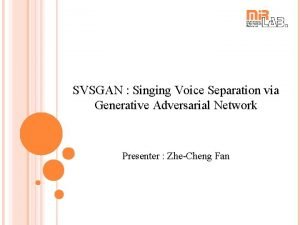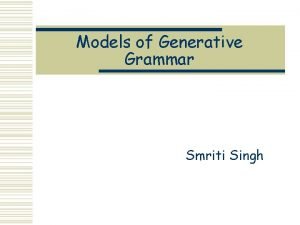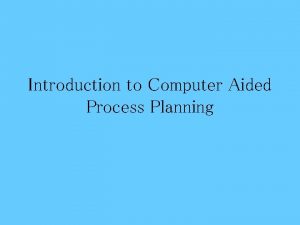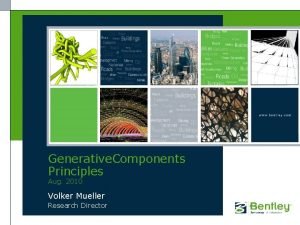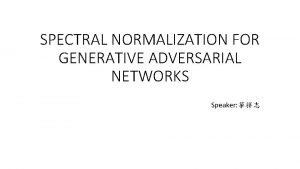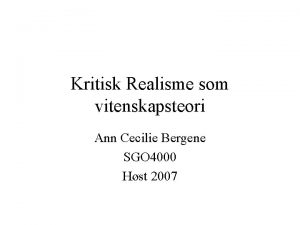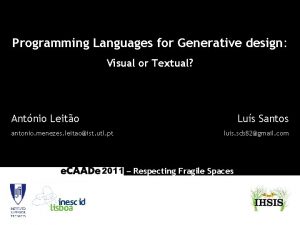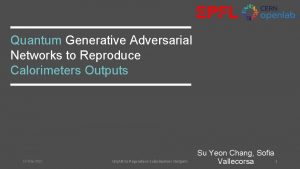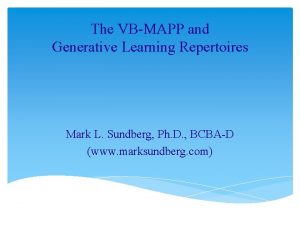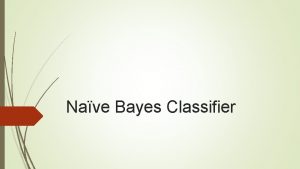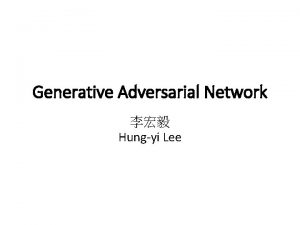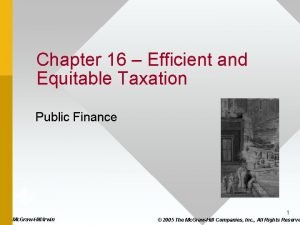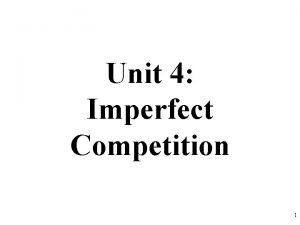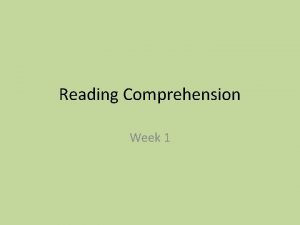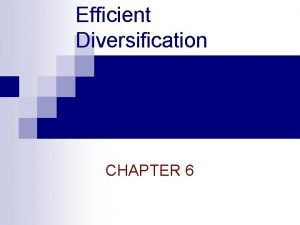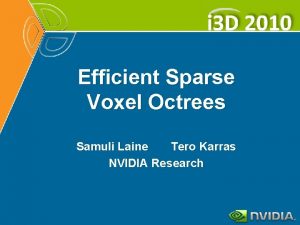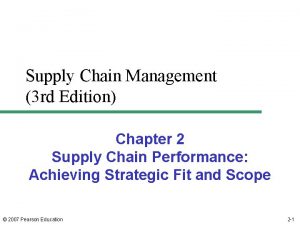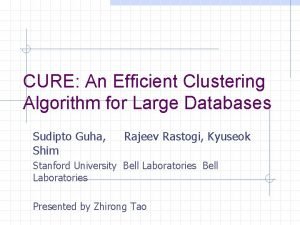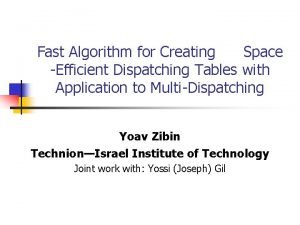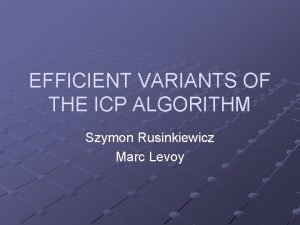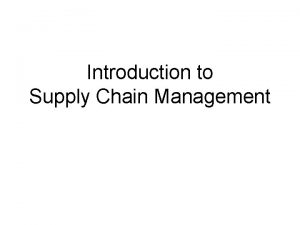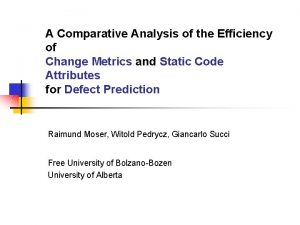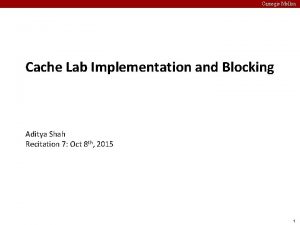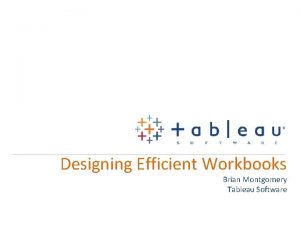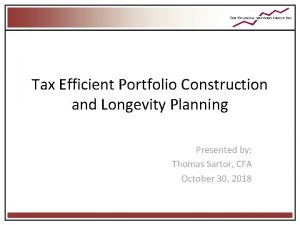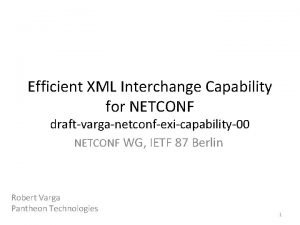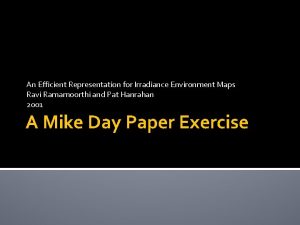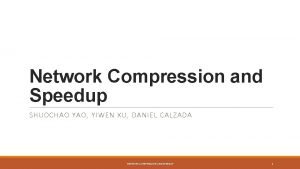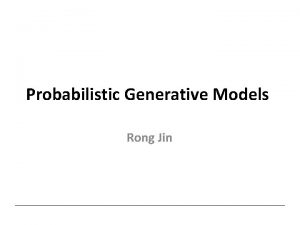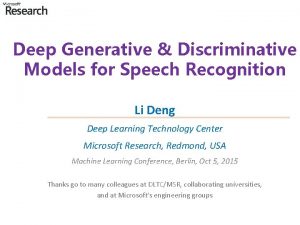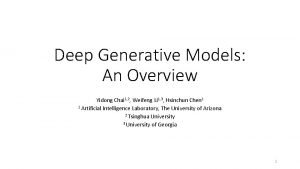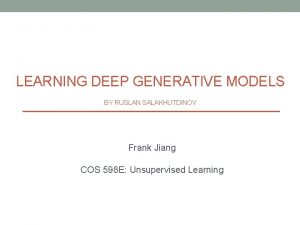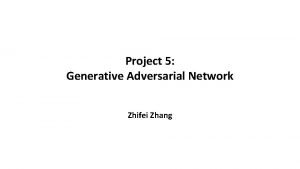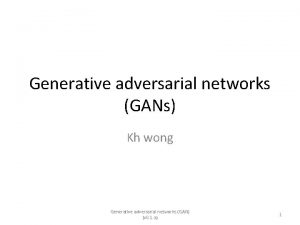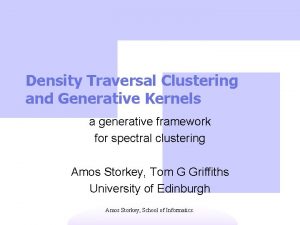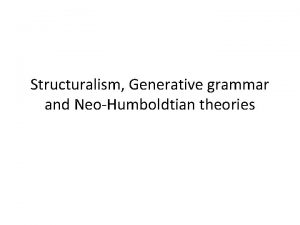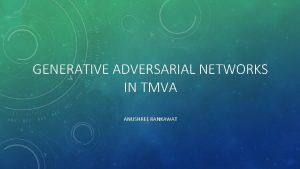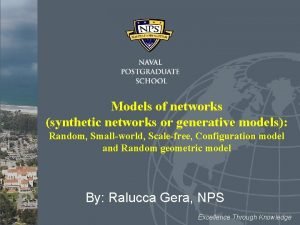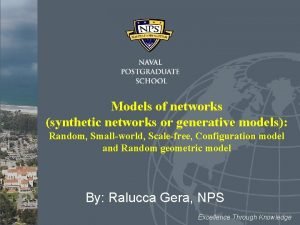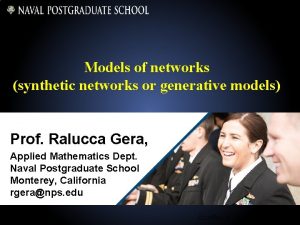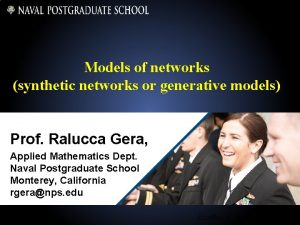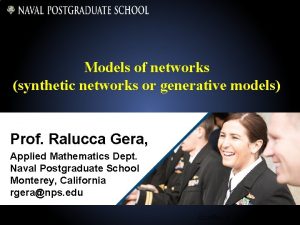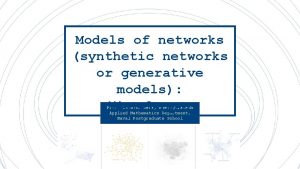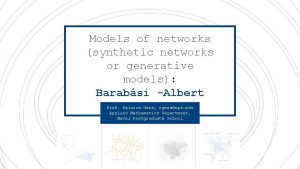An efficient way to learn deep generative models
















































































- Slides: 80

An efficient way to learn deep generative models Geoffrey Hinton Canadian Institute for Advanced Research & Department of Computer Science University of Toronto Joint work with: Ruslan Salakhutdinov, Yee -Whye Teh, Simon Osindero, Ilya Sutskever, Graham Taylor, Andriy Mnih

Belief Nets • A belief net is a directed acyclic graph composed of stochastic variables. • We get to observe some of the variables and we would like to solve two problems: • The inference problem: Infer the states of the unobserved variables. • The learning problem: Adjust the interactions between variables to make the network more likely to generate the observed data. stochastic hidden cause visible effect We will use nets composed of stochastic binary variables with weighted connections

Stochastic binary neurons • These have a state of 1 or 0. • The probability of turning on is determined by the weighted input from other neurons (plus a bias) 1 0 0

Learning Belief Nets • It is easy to generate an unbiased example at the leaf nodes, so we can see what kinds of data the network believes in. • It is hard to infer the posterior distribution over all possible configurations of hidden causes. • It is hard to even get a sample from the posterior. • So how can we learn deep belief nets that have millions of parameters? stochastic hidden cause visible effect

Explaining away (Judea Pearl) • Even if two hidden causes are independent, they can become dependent when we observe an effect that they can both influence. – If we learn that there was an earthquake it reduces the probability that the house jumped because of a truck. -10 truck hits house -10 20 -20 earthquake 20 house jumps

Why it is usually very hard to learn sigmoid belief nets one layer at a time • To learn W, we need the posterior distribution in the first hidden layer. • Problem 1: The posterior is typically intractable because of “explaining away”. • Problem 2: The posterior depends on the prior as well as the likelihood. – So to learn W, we need to know the weights in higher layers, even if we are only approximating the posterior. All the weights interact. • Problem 3: We need to integrate over all possible configurations of the higher variables to get the prior first hidden layer. Yuk! hidden variables prior hidden variables likelihood data W

Two types of generative neural network • If we connect binary stochastic neurons in a directed acyclic graph we get a Sigmoid Belief Net (Radford Neal 1992). • If we connect binary stochastic neurons using symmetric connections we get a Boltzmann Machine (Hinton & Sejnowski, 1983). – If we restrict the connectivity in a special way, it is easy to learn a Boltzmann machine.

Restricted Boltzmann Machines • We restrict the connectivity to make learning easier. – Only one layer of hidden units. hidden j • We will deal with more layers later – No connections between hidden units. • In an RBM, the hidden units are conditionally independent given the visible states. – So we can quickly get an unbiased sample from the posterior distribution when given a data-vector. – This is a big advantage over directed belief nets i visible

Weights Energies Probabilities • Each possible joint configuration of the visible and hidden units has an energy – The energy is determined by the weights and biases (as in a Hopfield net). • The energy of a joint configuration of the visible and hidden units determines its probability: • The probability of a configuration over the visible units is found by summing the probabilities of all the joint configurations that contain it.

The Energy of a joint configuration (ignoring terms to do with biases) binary state of visible unit i Energy with configuration v on the visible units and h on the hidden units binary state of hidden unit j weight between units i and j

A picture of the maximum likelihood learning algorithm for an RBM j j a fantasy i i i t=0 t=1 t=2 i t = infinity Start with a training vector on the visible units. Then alternate between updating all the hidden units in parallel and updating all the visible units in parallel.

A quick way to learn an RBM j j Start with a training vector on the visible units. Update all the hidden units in parallel i t=0 data i t=1 reconstruction Update the all the visible units in parallel to get a “reconstruction”. Update the hidden units again. This is not following the gradient of the log likelihood. But it works well. It is approximately following the gradient of another objective function.

How to learn a set of features that are good for reconstructing images of the digit 2 50 binary feature neurons Decrement weights between an active pixel and an active feature Increment weights between an active pixel and an active feature 16 x 16 pixel image data (reality) reconstruction (better than reality)

The weights of the 50 feature detectors We start with small random weights to break symmetry

















The final 50 x 256 weights Each neuron grabs a different feature.

How well can we reconstruct the digit images from the binary feature activations? Data Reconstruction from activated binary features New test images from the digit class that the model was trained on Data Reconstruction from activated binary features Images from an unfamiliar digit class (the network tries to see every image as a 2)

Training a deep network • First train a layer of features that receive input directly from the pixels. • Then treat the activations of the trained features as if they were pixels and learn features of features in a second hidden layer. • It can be proved that each time we add another layer of features we get a better model of the set of training images. – The proof is complicated. It uses variational free energy, a method that physicists use for analyzing non-equilibrium systems. – But it is based on a neat equivalence (described later)

The generative model after learning 3 layers • To generate data: 1. Get an equilibrium sample from the top-level RBM by performing alternating Gibbs sampling. 2. Perform a top-down pass to get states for all the other layers. So the lower level bottom-up connections are not part of the generative model. They are just used for inference. h 3 h 2 h 1 data

Why does greedy learning work? The weights, W, in the bottom level RBM define p(v|h) and they also, indirectly, define p(h). So we can express the RBM model as If we leave p(v|h) alone and build a better model of p(h), we will improve p(v). We need a better model of the aggregated posterior distribution over hidden vectors produced by applying W to the data.

What does each RBM achieve? • It divides the task of modeling the data into two tasks and leaves the second task to the next RBM – Task 1: Learn generative weights that can convert the posterior distribution over the hidden units into the data. – Task 2: Learn to model the posterior distribution over the hidden units that is produced by applying the transpose of the generative weights to the data • Task 2 is guaranteed to be easier (for the next RBM) than modeling the original data. h v

A neural model of digit recognition The top two layers form an associative memory whose energy landscape models the low dimensional manifolds of the digits. The energy valleys have names 2000 top-level neurons 10 label neurons The model learns to generate combinations of labels and images. To perform recognition we start with a neutral state of the label units and do an up-pass from the image followed by a few iterations of the top-level associative memory. 500 neurons 28 x 28 pixel image

Fine-tuning with a contrastive divergence version of the wake-sleep algorithm • After learning many layers of features, we can fine-tune the features to improve generation. • 1. Do a stochastic bottom-up pass – Adjust the top-down weights to be good at reconstructing the feature activities in the layer below. • 2. Do a few iterations of sampling in the top level RBM – Use CD learning to improve the RBM • 3. Do a stochastic top-down pass – Adjust the bottom-up weights to be good at reconstructing the feature activities in the layer above.

Show the movie of the network generating digits (available at www. cs. toronto/~hinton)

Samples generated by letting the associative memory run with one label clamped. There are 1000 iterations of alternating Gibbs sampling between samples.

What goes on in its mind if we show it an image composed of random pixels and ask it to fantasize from there? mind brain 2000 top-level neurons 10 label mind brain neurons 500 neurons mind brain 28 x 28 pixel image

Examples of correctly recognized handwritten digits that the neural network had never seen before Its very good

How well does it discriminate on MNIST test set with no extra information about geometric distortions? • • • Generative model based on RBM’s 1. 25% Support Vector Machine (Decoste et. al. ) 1. 4% Backprop with 1000 hiddens (Platt) ~1. 6% Backprop with 500 -->300 hiddens ~1. 6% K-Nearest Neighbor ~ 3. 3% • Its better than backprop and much more neurally plausible because the neurons only need to send one kind of signal, and the teacher can be another sensory input.

The features learned in the first hidden layer

Show the faces demo (available at www. cs. toronto/~hinton)

Another view of why layer-by-layer learning works • There is an unexpected equivalence between RBM’s and directed networks with many layers that all use the same weights. – This equivalence also gives insight into why contrastive divergence learning works.

An infinite sigmoid belief net that is equivalent to an RBM • The distribution generated by this infinite directed net with replicated weights is the equilibrium distribution for a compatible pair of conditional distributions: p(v|h) and p(h|v) that are both defined by W – A top-down pass of the directed net is exactly equivalent to letting a Restricted Boltzmann Machine settle to equilibrium. – So this infinite directed net defines the same distribution as an RBM. etc. h 2 v 2 h 1 v 1 h 0 v 0

Inference in a directed net with replicated weights • The variables in h 0 are conditionally independent given v 0. – Inference is trivial. We just multiply v 0 by W transpose. – The model above h 0 implements a complementary prior. – Multiplying v 0 by W transpose gives the product of the likelihood term and the prior term. • Inference in the directed net is exactly equivalent to letting a Restricted Boltzmann Machine settle to equilibrium starting at the data. etc. h 2 v 2 h 1 v 1 + + h 0 + + v 0

Learning a deep directed network • First learn with all the weights tied – This is exactly equivalent to learning an RBM – Contrastive divergence learning is equivalent to ignoring the small derivatives contributed by the tied weights between deeper layers. etc. h 2 v 2 h 1 v 1 h 0 v 0

• Then freeze the first layer of weights in both directions and learn the remaining weights (still tied together). – This is equivalent to learning another RBM, using the aggregated posterior distribution of h 0 as the data. etc. h 2 v 2 h 1 v 1 h 0 v 0

What happens when the weights in higher layers become different from the weights in the first layer? • The higher layers no longer implement a complementary prior. – So performing inference using the frozen weights in the first layer is no longer correct. – Using this incorrect inference procedure gives a variational lower bound on the log probability of the data. • We lose by the slackness of the bound. • The higher layers learn a prior that is closer to the aggregated posterior distribution of the first hidden layer. – This improves the network’s model of the data. • Hinton, Osindero and Teh (2006) prove that this improvement is always bigger than the loss.

Using backpropagation for fine-tuning • Greedily learning one layer at a time scales well to really big networks, especially if we have locality in each layer. • We do not start backpropagation until we already have sensible weights that already do well at the task. – So the initial gradients are sensible and backprop only needs to perform a local search. • Most of the information in the final weights comes from modeling the distribution of input vectors. – The precious information in the labels is only used for the final fine-tuning. It slightly modifies the features. It does not need to discover features.

First, model the distribution of digit images The top two layers form a restricted Boltzmann machine whose free energy landscape should model the low dimensional manifolds of the digits. 2000 units 500 units The network learns a density model for unlabeled digit images. When we generate from the model we often get things that look 500 units like real digits of all classes. But do the hidden features really help with digit discrimination? Add 10 softmaxed units to the top and do backpropagation. 28 x 28 pixel image

Results on permutation-invariant MNIST task • Very carefully trained backprop net with one or two hidden layers (Platt; Hinton) 1. 6% • SVM (Decoste & Schoelkopf) 1. 4% • Generative model of joint density of images and labels (+ generative fine-tuning) 1. 25% • Generative model of unlabelled digits followed by gentle backpropagation 1. 15%

Time series models • Inference is difficult in directed models of time series if they are non-linear and they use distributed representations. • So people tend to avoid distributed representations and use exponentially weaker methods (HMM’s) that are based on the idea that each visible frame of data has a single hidden cause – During generation from an HMM, each frame comes from one hidden state of the HMM

A conditional RBM model (Sutskever, Taylor) • Given the current and previous data, the hidden units at time t are conditionally independent. – So online inference is very easy. – Generation from a learned model requires alternating Gibbs sampling but typically converges rapidly. • Learning can be done by using contrastive divergence. – Reconstruct the data at time t from the inferred states of the hidden units. – The temporal connections between hiddens can be learned as if they were additional biases t t-2 t-1 t

A hierarchical version • Hierarchical versions can be trained one layer at a time. – This is a major advantage of CRBM’s. • The hierarchical versions are directed at all but the top two layers. • They work well for generation and for filtering out nasty noise from image sequences.

An application to modeling motion capture data • Human motion can be captured by placing reflective markers on the joints and then using lots of infrared cameras to track the 3 -D positions of the markers. • The 3 -D positions of the markers can be converted into a frame of data containing: – all the joint angles – 3 variables for the translation of the pelvis – 3 variables for the orientation of the pelvis

Modeling multiple types of motion • We can easily learn to model walking and running in a single model. • This means we can share a lot of knowledge. • It also makes it much easier to learn nice transitions between walking and running.

Show Graham Taylor’s movies (available via www. cs. toronto/~hinton)

Summary so far • Restricted Boltzmann Machines provide a simple way to learn a layer of features without any supervision. • Many layers of representation can be learned by treating the hidden states of one RBM as the visible data for training the next RBM (a composition of experts). • This creates good generative models that can then be fine-tuned. – Backpropagation can fine-tune discrimination. – Contrastive wake-sleep can fine-tune generation. • The same ideas can be applied to high-dimensional sequential data.

Deep Autoencoders (Ruslan Salakhutdinov) • They always looked like a really nice way to do non-linear dimensionality reduction: – But it is very difficult to optimize deep autoencoders using backpropagation. • We now have a much better way to optimize them: – First train a stack of 4 RBM’s – Then “unroll” them. – Then fine-tune with backprop. 28 x 28 1000 neurons 500 neurons 250 neurons 30 250 neurons 500 neurons 1000 neurons 28 x 28

A comparison of methods for compressing digit images to 30 real numbers. real data 30 -D deep auto 30 -D logistic PCA 30 -D PCA

Do the 30 -D codes found by the autoencoder preserve the class structure of the data? • Take the 30 -D activity patterns in the code layer and display them in 2 -D using a new form of non -linear multi-dimensional scaling (UNI-SNE) • Will the learning find the natural classes?

entirely unsupervised except for the colors

How to compress document count vectors 2000 reconstructed counts 500 neurons 250 neurons 2 250 neurons 500 neurons 2000 word counts output vector • We train the autoencoder to reproduce its input vector as its output • This forces it to compress as much information as possible into the 2 real numbers in the central bottleneck. • These 2 numbers are then a good way to visualize documents. Input vector uses Poisson units

First compress all documents to 2 numbers using a type of PCA Then use different colors for different document categories

First compress all documents to 2 numbers. Then use different colors for different document categories

The fastest possible way to find similar documents • Given a query document, how long does it take to find a shortlist of 10, 000 similar documents in a set of one billion documents? – Would you be happy with one millesecond?

Finding binary codes for documents 2000 reconstructed counts • Train an auto-encoder using 30 logistic units for the code layer. • During the fine-tuning stage, add noise to the inputs to the code units. – The “noise” vector for each training case is fixed. So we still get a deterministic gradient. – The noise forces their activities to become bimodal in order to resist the effects of the noise. – Then we simply round the activities of the 30 code units to 1 or 0. 500 neurons 250 neurons 30 noise 250 neurons 500 neurons 2000 word counts

Making address space semantic • At each 30 -bit address, put a pointer to all the documents that have that address. • Given the 30 -bit code of a query document, we can perform bit-operations to find all similar binary codes. – Then we can just look at those addresses to get the similar documents. – The “search” time is independent of the size of the document set and linear in the size of the shortlist. • Using an autoencoder we can design a hashfunction that finds approximate matches

A hash-function for finding approximate matches hash function

How good is a shortlist found this way? • We have only implemented it for a million documents with 20 -bit codes --- but what could possibly go wrong? – A 20 -D hypercube allows us to capture enough of the similarity structure of our document set. • The shortlist found using binary codes actually improves the precision-recall curves of TF-IDF. – Locality sensitive hashing (the fastest other method) is 50 times slower and always performs worse than TF-IDF alone.

THE END

Why the hidden configurations should be treated as data when learning the next layer of weights • After learning the first layer of weights: • If we freeze the generative weights that define the likelihood term and the recognition weights that define the distribution over hidden configurations, we get: • Maximizing the RHS is equivalent to maximizing the log prob of “data” that occurs with probability If we start the second level RBM at the learned weights of the first level RBM we cannot lose.

Using energies to define probabilities • The probability of a joint configuration over both visible and hidden units depends on the energy of that joint configuration compared with the energy of all other joint configurations. • The probability of a configuration of the visible units is the sum of the probabilities of all the joint configurations that contain it. partition function

An RBM with real-valued visible units energy F • In a mean-field logistic unit, the total input provides a linear energygradient and the negative entropy provides a containment function with fixed curvature. So it is impossible for the value 0. 7 to have much lower free energy than both 0. 8 and 0. 6. This is no good for modeling realvalued data. • Using Gaussian visible units we can get much sharper predictions and alternating Gibbs sampling is still easy, though learning is slower. - entropy 0 output-> 1

The non-linearity used for reconstructing bags of words • Divide the counts in a bag of words vector by N, where N is the total number of non-stop words in the document. – The resulting probability vector gives the probability of getting a particular word if we pick a non-stop word at random from the document. • At the output of the autoencoder, we use a softmax. – The probability vector defines the desired outputs of the softmax. • When we train the first RBM in the stack we use the same trick. – We treat the word counts as probabilities, but we make the visible to hidden weights N times bigger than the hidden to visible because we have N observations from the probability distribution.

Performance of the autoencoder at document retrieval • Train on bags of 2000 words for 400, 000 training cases of business documents. – First train a stack of RBM’s. Then fine-tune with backprop. • Test on a separate 400, 000 documents. – Pick one test document as a query. Rank order all the other test documents by using the cosine of the angle between codes. – Repeat this using each of the 400, 000 test documents as the query (requires 0. 16 trillion comparisons). • Plot the number of retrieved documents against the proportion that are in the same hand-labeled class as the query document. Compare with LSA (a version of PCA).

Proportion of retrieved documents in same class as query Number of documents retrieved
 On unifying deep generative models
On unifying deep generative models Do deep generative models know what they don’t know?
Do deep generative models know what they don’t know? Taxonomy of generative models
Taxonomy of generative models Generative vs discriminative
Generative vs discriminative Lucas theis
Lucas theis Productively efficient vs allocatively efficient
Productively efficient vs allocatively efficient Productively efficient vs allocatively efficient
Productively efficient vs allocatively efficient Productive inefficiency and allocative inefficiency
Productive inefficiency and allocative inefficiency Allocative efficiency
Allocative efficiency Productively efficient vs allocatively efficient
Productively efficient vs allocatively efficient Efficient processing of deep neural networks pdf
Efficient processing of deep neural networks pdf Kinesthetic learner
Kinesthetic learner Using the body in an efficient and careful way is
Using the body in an efficient and careful way is Deep asleep deep asleep it lies
Deep asleep deep asleep it lies 深哉深哉
深哉深哉 Deep forest: towards an alternative to deep neural networks
Deep forest: towards an alternative to deep neural networks Kubernetes vgpu
Kubernetes vgpu How to remember the reactivity series of metals
How to remember the reactivity series of metals How is technology changing the way we learn
How is technology changing the way we learn Understand quran and salah the easy way
Understand quran and salah the easy way Learn your way
Learn your way Deep down in my soul gospel
Deep down in my soul gospel What is modals and semi modals
What is modals and semi modals Generative recursion
Generative recursion Hudson culture ladder
Hudson culture ladder Generative grammar examples
Generative grammar examples Generative linguistics and cognitive psychology
Generative linguistics and cognitive psychology Generative grammar
Generative grammar Generative meditation
Generative meditation Deep structure in linguistics
Deep structure in linguistics Generative lymphoid organs
Generative lymphoid organs Nlp generative model
Nlp generative model Lda generative model
Lda generative model Generative adversarial network
Generative adversarial network Transformational grammar
Transformational grammar Advantages of capp
Advantages of capp Bentley generative components
Bentley generative components Generative thinking boards
Generative thinking boards Oren freifeld
Oren freifeld Generative thinking definition
Generative thinking definition Spectral normalization for generative adversarial networks
Spectral normalization for generative adversarial networks Kritisk realisme definisjon
Kritisk realisme definisjon Generative design grasshopper
Generative design grasshopper Quantum generative adversarial learning
Quantum generative adversarial learning What is generative learning aba
What is generative learning aba Generative vs discriminative
Generative vs discriminative Conditional generator
Conditional generator What does one way anova tell you
What does one way anova tell you Bottle of rum to fill my tum
Bottle of rum to fill my tum Two way anova
Two way anova One way anova vs two way anova
One way anova vs two way anova Walk this way talk this way
Walk this way talk this way Advantage of threaded binary tree
Advantage of threaded binary tree Analiza anova
Analiza anova Perbedaan two way anova dan one way anova
Perbedaan two way anova dan one way anova Conventional software engineering
Conventional software engineering How to do a two way frequency table
How to do a two way frequency table Efficient and equitable taxation
Efficient and equitable taxation Efficient markets theory
Efficient markets theory Efficient frontier case study
Efficient frontier case study Socially optimal quantity
Socially optimal quantity It is an arrangement of people in an organization.
It is an arrangement of people in an organization. What is efficient reading
What is efficient reading Global tax structuring
Global tax structuring The efficient market hypothesis suggests that _______.
The efficient market hypothesis suggests that _______. What is efficient diversification
What is efficient diversification Efficient sparse voxel octrees
Efficient sparse voxel octrees Cost-responsiveness efficient frontier
Cost-responsiveness efficient frontier Efficient quantity
Efficient quantity Cure: an efficient clustering algorithm for large databases
Cure: an efficient clustering algorithm for large databases Efficient dispatching
Efficient dispatching Efficient variants of the icp algorithm
Efficient variants of the icp algorithm Replenishment cycle in supply chain
Replenishment cycle in supply chain Efficient comparative and superlative
Efficient comparative and superlative Cache blocking matrix transpose
Cache blocking matrix transpose Non-efficient
Non-efficient Designing efficient workbooks
Designing efficient workbooks Efficient portfolio construction
Efficient portfolio construction Efficient xml interchange
Efficient xml interchange An efficient representation for irradiance environment maps
An efficient representation for irradiance environment maps Dynamic network surgery for efficient dnns
Dynamic network surgery for efficient dnns
